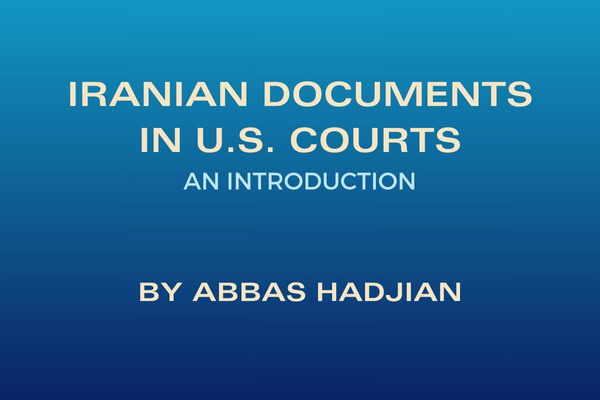Iranian documents presented to the U.S. Courts can be divided into Genuine and Fake categories. It’s crucial to note that in my experience, with a focus on Iranian transactions and litigation, fake documents outnumber genuine ones by more than 50%. This alarming prevalence underscores the urgent need for heightened vigilance and scrutiny when dealing with foreign documents, emphasizing the crucial role of legal professionals in detecting and preventing document fraud.
Genuine Iranian Documents
Iranian Genuine documents are certified, translated, authenticated, and must be interpreted. These processes are not just formalities but crucial steps in ensuring the authenticity and reliability of these documents in legal proceedings.
Certification is a crucial aspect of dealing with foreign documents, and it is essential to understand the process under Iranian law. Iranian law allows attorneys to certify a document prepared by them and in their office, but not the court or other agencies’ records. Mahzar, the notaries who handle deeds and real estate transactions, must certify the documents by placing a government-issued verification code and password on the certified documents. The courts assign 16-digit credit-card-style numbers for the filed documents and provide certified duplicate originals where required.
Translation of Iranian Documents
Iran is a non-English Farsi-speaking nation, and its documents must be translated. The translators are certified and have assigned membership numbers and identification seals. The Iranian Association of Certified Translators and Interpreters (IACTI) issues the certifications. The translators are not graduates of law schools in Iran or the U.S. and are not familiar with the Islamic terminologies used in the Iranian Civil Code and their equivalence and difference in the U.S. Common-Law System. The level of language proficiency is the “Test of English as a Foreign Language” (TOEFL).
Knowledge of Islamic Law and Civil Code is required, but not as an attorney or law graduate. The recommended legal source is Law Made Simple, published in South Africa. Any translated legal document suffers from a lack of familiarity with the legal terms on both ends. Even honest and accurate translations of Iranian Sharia and Civil Law and procedures necessitate finding correspondence with the secular legal concepts of the U.S. Common law.
Translators’ place of birth, schooling, and higher education are influenced by the usage and meaning of the words in more than 110 dialects nationwide. The geographical identity of the parties and the translator affects the understanding of the law and the use of terminologies in translated documents.
Authentication of Iranian Documents
The lack of consular relationships between the U.S. and Iran has required the development of a substitute informal, indirect four (4) step authentication process: 1) Verification of the translator’s qualifications by ACTI; 2) Verification of ACI’s seal by the Department Of Justice (DOJ); 3) Verification of seal of the DOJ by the Iranian Secretary of State (SOS); and 4) Verification of the Iranian SOS, by the Swiss Embassy, protector of the U.S. Interest in Iran must certify the SOS seal.
Interpretation
I italicized “interpretation” to assert its role and significance in understanding Iranian legal translations.
The Iranian legal system is French-German-based civil law infused with Islamic Sharia guidelines. Its Personal Status Law (Birth, Marriage, Divorce, and Death) applies to Iranians globally. Still, it differs from the Roman-infused Spanish and the precedent-led Common Law. Concepts of Discovery, Evidence, and judicial neutrality are different. The terminology and usage of the legal institutions like “Life Estate,” “Trust,” and “Child Custody and Support “do not match their equivalent here. Iranian and American evidentiary processes and burden of proof are different and must be tested, analyzed, and interpreted.
As a result, most Iranian legal documents are not directly admissible, and the assistance of a qualified interpreter familiar with both systems is needed.
Fake Iranian Documents Presented to U.S. Courts
It is impractical to classify. They come in many forms and formats as fraudulent minds and interests intersect. Principal common grounds exist:
- Missing one or more steps listed above. Often produced on the wrong forms by the wrong offices and officers.
- Lacking necessary details or containing irrelevant and unnecessary information.
- Missing identification of the producer or the translator.
- Internal inconsistencies (e.g., Iranian dates do not match their equivalent in English).
- External consistencies (e.g., information in the birth certificates, do not match marriage certificates or immigration records).
- References to vague and hard-to-identify individuals, organizations, property, value, time, and location.
- Lacking a verifiable and reliable chain of custody. The document appears magically out of the blue, at the last minute, in the hands of the person benefiting from it.
Northridge, California. 2024/07/06.
Iranian Documents in U.S. Courts. Daily Journal.
View a recent case in which The Law Offices of Abbas Hadjian, APC provided Iranian documents expertise.
Request a testimony consultation from an expert in Iranian Family Law.
